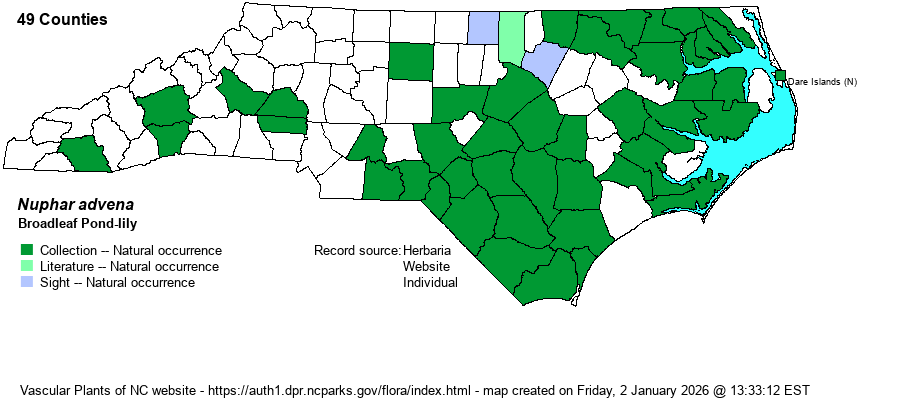| Author | (Aiton) R. Brown ex W.T. Aiton | |
| Distribution | Throughout the Coastal Plain and lower Piedmont, but only a single record from the Outer Banks (Nags Head Woods). Widely scattered over most of the remainder of the Piedmont and southern Mountains, but scarce or absent from the northwestern Piedmont and northern Mountains.
A widespread range across the eastern US, mainly from ME, southern Ont., and WI south to FL and TX. Also Cuba and northern Mex. | |
| Abundance | Fairly common to common across the Coastal Plain and Sandhills, and at least locally fairly common in the eastern edge of the Piedmont. Rare in most of the Piedmont and southern Mountains. No records known from north of Buncombe, Burke, and Catawba counties. | |
| Habitat | This is an aquatic species of slow waters, both in brownwater and blackwater conditions. It is usually found in lakes and ponds, including millponds, impoundments, and beaver ponds, but it also can be found on slow-moving rivers, oxbows, and marshes. |
| Phenology | Blooms from April into October, and fruits during this same period. | |
| Identification | This species is a familiar one to people who spend time in the eastern half of the state around lakes and ponds. It has large rounded leaves (blades) with a strongly cordate or v-shaped cut at the base, growing to about 8-10 inches long and slightly less wide, typically 1.5-2 times longer than wide. These leaves are on long stalks below the water, holding the blades mostly off the water surface by a few inches; leaves can be angled upward or held somewhat horizontally, but at times these leaves can be floating (though floating leaves are more typical of the closely related N. sagittifolia). Both of these species have similar flowers -- a single fairly large rounded "cup" or ball of bright yellow flowers about 1-2 inches across, with the numerous petals essentially "glued" to the ovary and not spreading in early bloom but later spreading somewhat open. This species should be identifiable by most people even without the distinctive flower "ball", owing to the large elliptical leaves with a rounded tip and a V-cut to the leaf base at the petiole, and the leaves held off the water (and not typically floating as in Nymphaea odorata). As with most aquatic species, this one grows in sizable stands to the exclusion of other species. | |
| Taxonomic Comments | This species has often been named as Nuphar lutea or Nuphar luteum. Many older references consider N. sagittifolia as a variety or subspecies of N. advena. See that species for more details.
| |
| Other Common Name(s) | Often called Spatterdock or Common Spatterdock. Other frequent names include Cow-lily and Yellow Pond-lily. | |
| State Rank | S5 | |
| Global Rank | G5 | |
| State Status | | |
| US Status | | |
| USACE-agcp | OBL link |
| USACE-emp | OBL link |

